21 Essential Montessori Activities for Toddlers at Home: Engage, Learn, and Grow
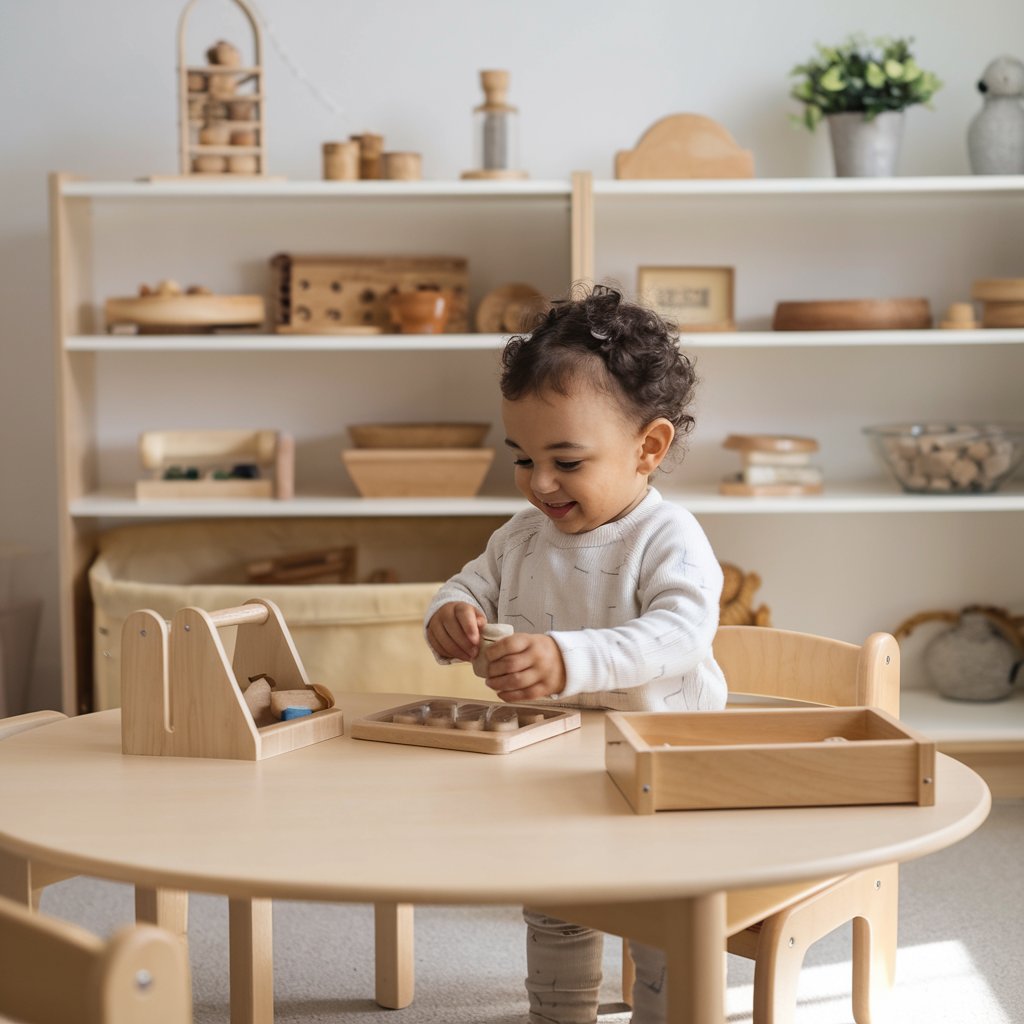
Last updated on September 16th, 2024 at 02:21 pm
Imagine watching your toddler confidently pour their own drink, sort objects by color, or even start recognizing letters and numbers – all through play! 🌟 These aren’t just pipe dreams; they’re real possibilities with Montessori activities.
By incorporating these into your daily routine, you’re not just occupying your child’s time – you’re laying the foundation for lifelong learning, independence, and creativity.
Many parents find themselves searching for meaningful activities that can foster their child’s development while keeping them entertained.
In this blog post, we’ll explore 21 Montessori activities for toddlers that you can easily implement at home. From practical life skills to sensory exploration, and language development to early math concepts, we’ve got you covered.
We’ll also guide you through setting up your own Montessori space, ensuring your toddler has the perfect environment to thrive. As part of your parenting journey, are you ready to embark on this exciting adventure of discovery with your little one?
Let’s dive in!
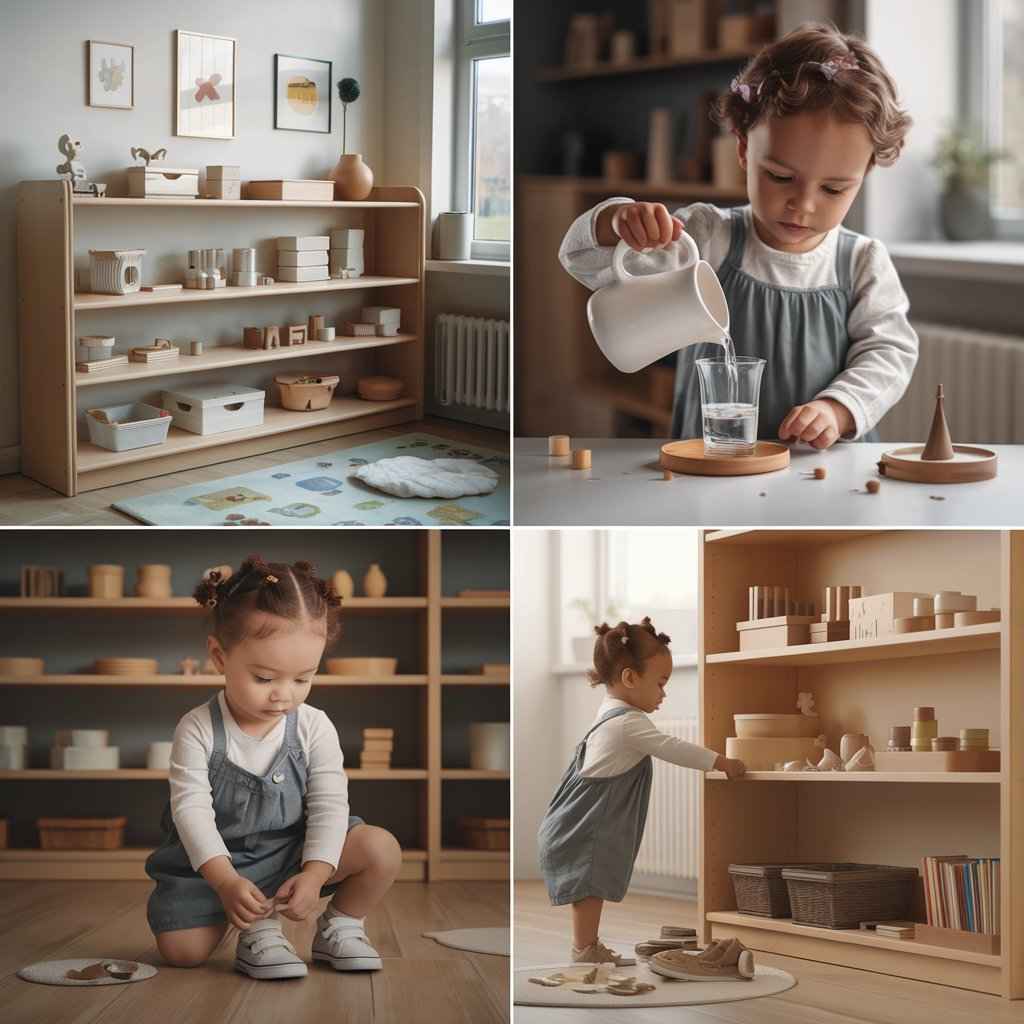
Understanding Montessori Activities for Toddlers
A. Prepared environment
Creating a prepared environment is crucial for your toddler’s Montessori learning experience. You’ll want to design a space that’s safe, accessible, and inviting for your little one. Arrange furniture and materials at your child’s eye level, allowing them to explore freely. Use low shelves to display a few carefully selected activities, rotating them regularly to maintain interest.
B. Hands-on experiences
Montessori emphasizes the importance of hands-on learning for toddlers. You’ll find that your child learns best through direct interaction with their environment. Provide materials that engage multiple senses, such as:
- Textured fabrics
- Wooden blocks
- Sensory bottles
- Shape sorters
These experiences help your toddler develop cognitive skills and fine motor abilities.
C. Fostering independence
Encouraging independence is a key aspect of Montessori education. You can support your toddler’s growing autonomy by:
- Offering child-sized tools and utensils
- Creating self-care stations (e.g., a low sink for handwashing)
- Allowing time for self-dressing
- Providing opportunities for simple food preparation
D. Child-led learning
In Montessori, you follow your child’s lead. Observe your toddler’s interests and provide activities that align with their current developmental stage. This approach nurtures their natural curiosity and love for learning.
| Montessori Principle | Benefits for Toddlers |
|---|---|
| Prepared Environment | Promotes exploration and safety |
| Hands-on Experiences | Enhances sensory development and cognitive skills |
| Fostering Independence | Builds self-confidence and practical life skills |
| Child-led Learning | Encourages intrinsic motivation and personal interests |
By implementing these principles, you’re creating a rich learning environment that supports your toddler’s growth and development. Next, we’ll explore specific Montessori activities you can introduce at home, starting with practical life skills.
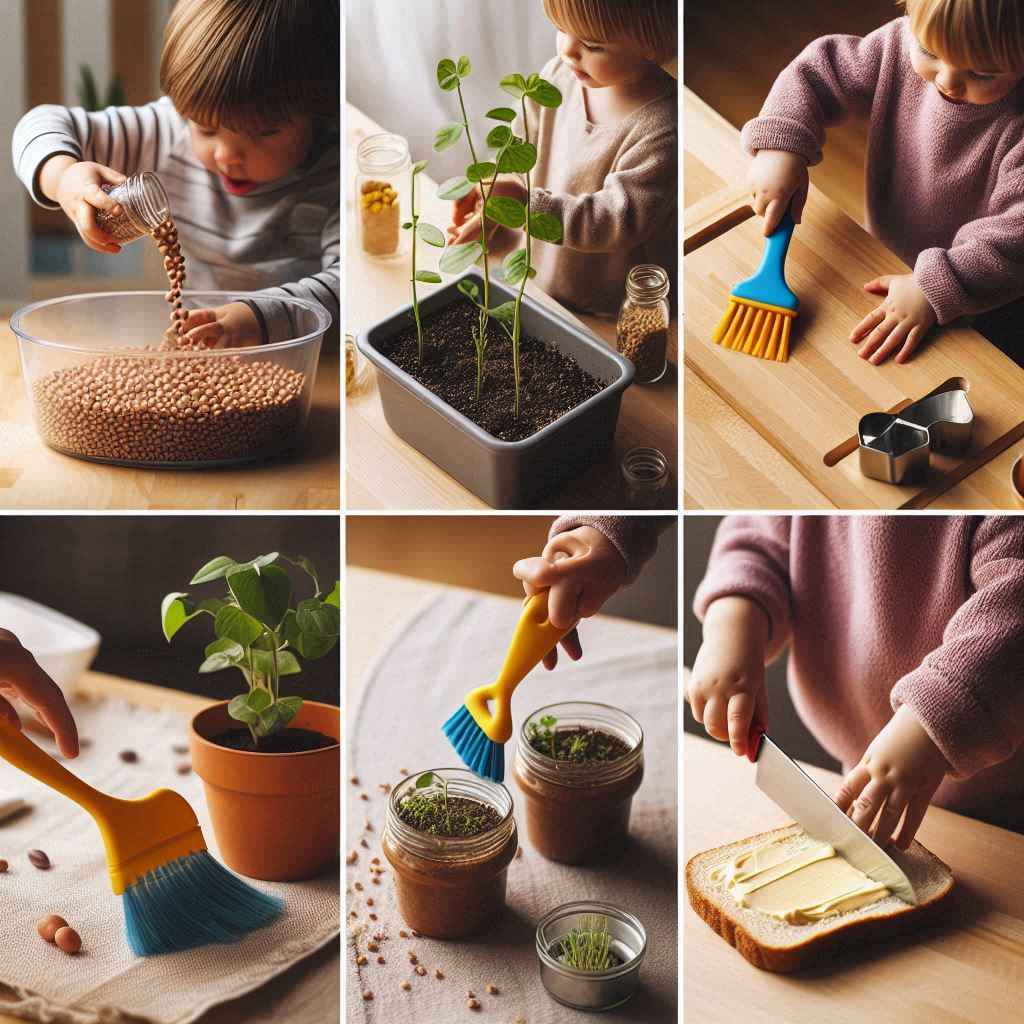
Practical Life Activities
Practical life activities are essential in Montessori education, helping your toddler develop independence, concentration, and fine motor skills. These activities are not only educational but also fun and engaging for your little one.
A. Pouring and Transferring
Pouring and transferring activities help your toddler refine their coordination and develop concentration. You can set up simple activities using:
- Water and different-sized containers
- Dry beans or rice with small pitchers
- Tongs or tweezers for transferring small objects
B. Dressing Frames
Dressing frames help your toddler learn to dress themselves, boosting their independence. You can create simple frames with:
- Buttons and buttonholes
- Zippers
- Velcro straps
- Snap fasteners
C. Food Preparation
Involving your toddler in food preparation teaches them valuable life skills and encourages healthy eating habits. Some age-appropriate tasks include:
- Washing fruits and vegetables
- Peeling bananas
- Spreading butter or jam on bread
- Using a child-safe knife to cut soft foods
D. Cleaning and Tidying
Teaching your toddler to clean and tidy up instills a sense of responsibility and care for their environment. Encourage them to:
- Wipe tables or spills with a small cloth
- Sweep with a child-sized broom
- Sort toys into appropriate bins or baskets
- Help with laundry by matching socks or folding small items
E. Caring for Plants
Caring for plants helps your toddler develop a connection with nature and learn about responsibility. You can:
- Let them water small plants with a child-sized watering can
- Help them plant seeds in small pots
- Teach them to gently wipe plant leaves
Here’s a table summarizing the benefits of these practical life activities:
| Activity | Skills Developed | Benefits |
|---|---|---|
| Pouring and Transferring | Fine motor skills, concentration | Improves hand-eye coordination |
| Dressing Frames | Self-care, independence | Boosts confidence and self-reliance |
| Food Preparation | Life skills, nutrition awareness | Encourages healthy eating habits |
| Cleaning and Tidying | Responsibility, organization | Develops a sense of order |
| Caring for Plants | Nature appreciation, nurturing | Teaches patience and responsibility |
By incorporating these practical life activities into your toddler’s daily routine, you’re helping them develop essential skills while fostering their independence and self-confidence. Remember to demonstrate each activity slowly and clearly, allowing your child to observe before trying it themselves. With patience and encouragement, you’ll see your toddler’s skills and independence grow.
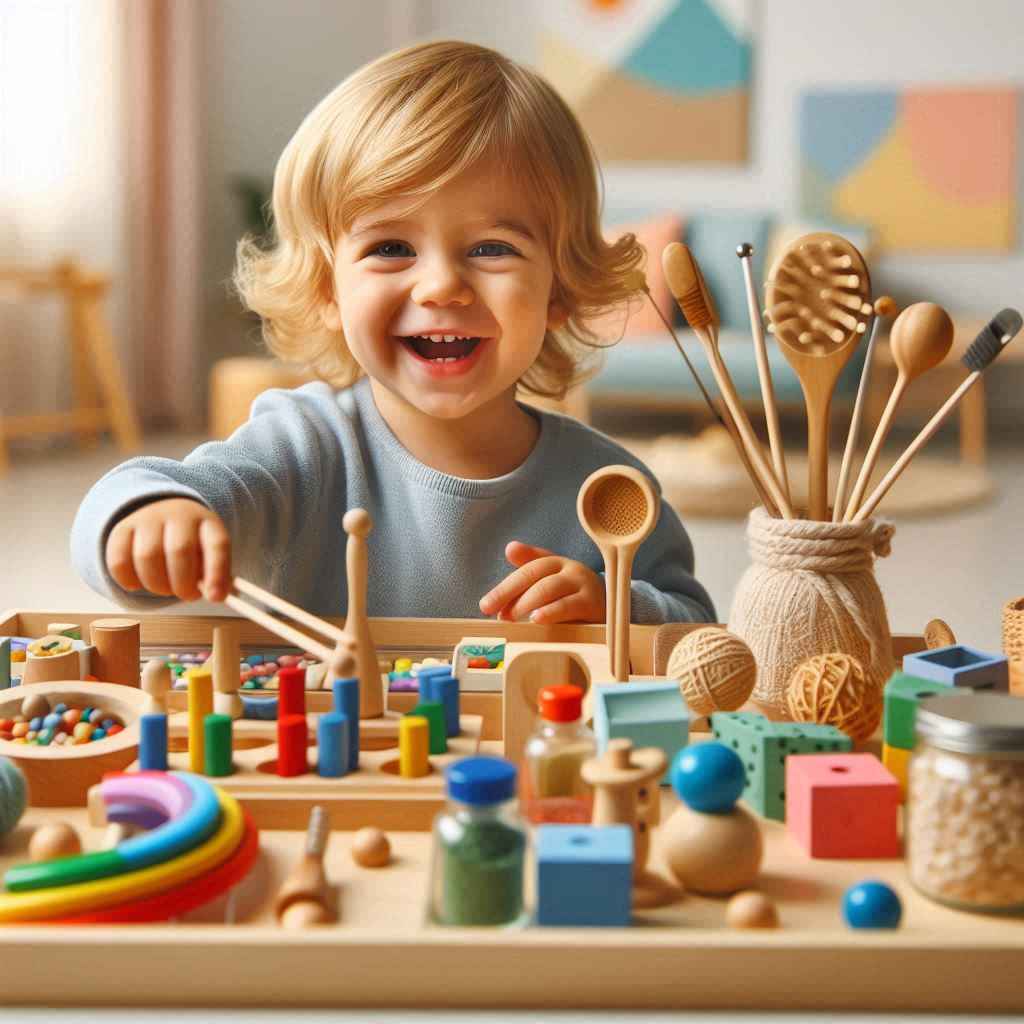
Sensorial Activities
Now that we’ve explored practical life activities, let’s dive into sensorial activities that engage your toddler’s senses and enhance their cognitive development.
A. Color Matching
Introduce your toddler to the world of colors with engaging matching activities. Use color tablets or create your own color cards for this purpose. Here’s a simple activity you can try:
- Gather pairs of colored objects or cards
- Spread them out on a tray or table
- Demonstrate matching colors
- Encourage your toddler to find and pair matching colors
| Benefits | Materials Needed |
|---|---|
| Color recognition | Color tablets or cards |
| Visual discrimination | Colored objects |
| Fine motor skills | Tray or table |
B. Texture Exploration
Engage your toddler’s sense of touch with texture boards or bags. This activity helps develop sensory awareness and vocabulary.
- Create a texture board with various materials (smooth, rough, bumpy, etc.)
- Guide your toddler to feel each texture
- Describe the textures using appropriate words
- Encourage your child to match similar textures
C. Sound Cylinders
Introduce your toddler to auditory discrimination with sound cylinders. This activity helps refine listening skills and concentration.
- Create pairs of cylinders filled with different materials (rice, beans, sand)
- Shake one cylinder and ask your toddler to find its matching pair
- Gradually increase the number of cylinders for added challenge
D. Smelling Bottles
Develop your toddler’s olfactory senses with smelling bottles. This activity enhances sensory awareness and vocabulary related to scents.
- Prepare small bottles with different scents (vanilla, lemon, mint)
- Let your toddler smell each bottle
- Describe the scents and ask your child to identify them
- Create matching pairs for more advanced play
These sensorial activities not only engage your toddler’s senses but also lay the foundation for future learning in various subjects. Next, we’ll explore language development activities that build on these sensory experiences.
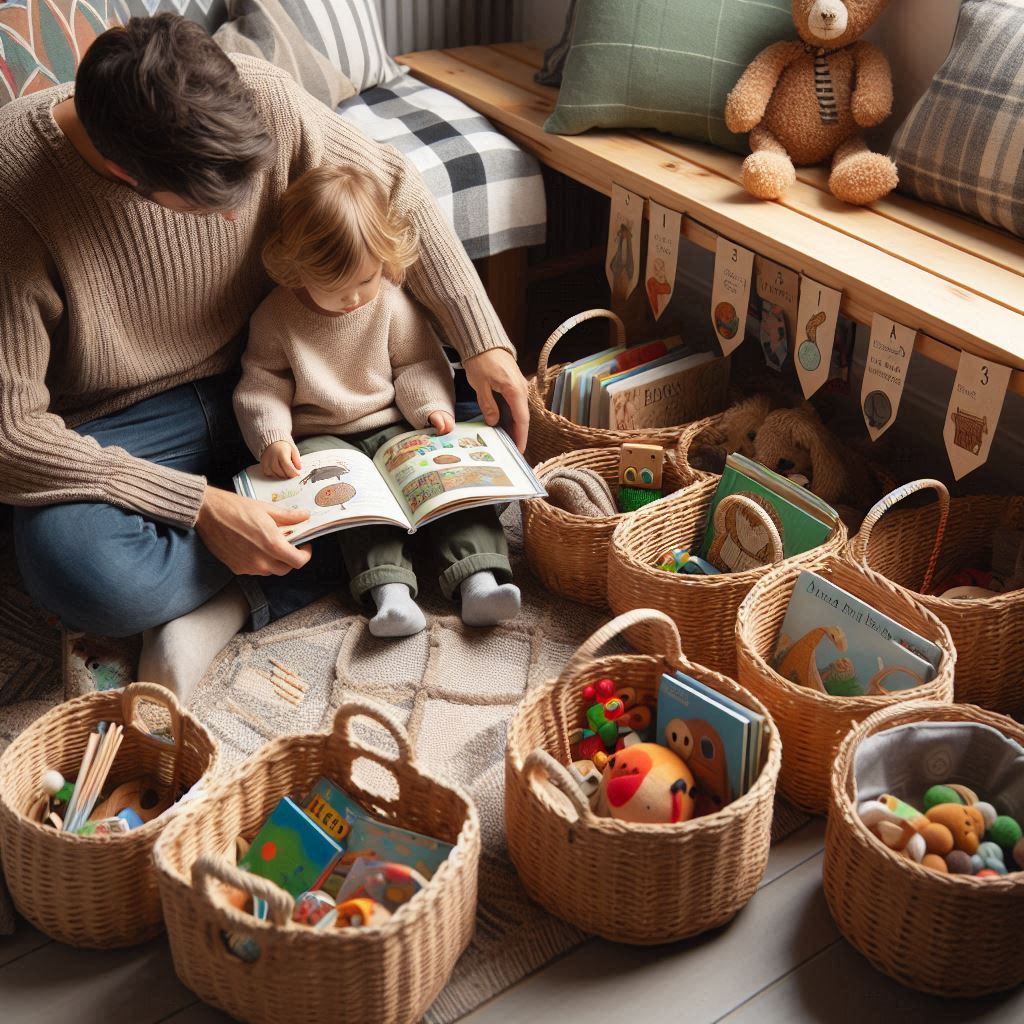
Language Development Activities
Now that we’ve explored sensorial activities, let’s dive into language development activities that can help your toddler build a strong foundation for communication and literacy.
A. Object naming baskets
Object naming baskets are an excellent way to introduce new vocabulary to your toddler. Here’s how you can create and use them:
- Choose a theme (e.g., animals, fruits, or household items)
- Collect small objects or miniatures related to the theme
- Place the objects in a shallow basket or tray
- Sit with your toddler and name each object as they explore
| Basket Theme | Example Objects |
|---|---|
| Animals | Toy elephant, plastic giraffe, wooden lion |
| Fruits | Plastic apple, felt banana, wooden orange |
| Kitchen | Miniature spoon, small cup, toy plate |
B. Picture-word matching
This activity helps toddlers associate written words with images, laying the groundwork for reading skills:
- Create or purchase cards with pictures and corresponding words
- Start with a small set of 3-5 cards
- Show your toddler the picture and say the word
- Gradually introduce matching the picture to the written word
C. Storytelling with props
Enhance your toddler’s language skills through interactive storytelling:
- Use simple props or toys to act out familiar stories
- Encourage your toddler to participate by making sounds or repeating key phrases
- Create opportunities for your child to manipulate the props and tell parts of the story
D. Sound games
Develop phonological awareness with these fun sound activities:
- I-Spy: “I spy with my little eye something that starts with the ‘b’ sound”
- Rhyming pairs: Match objects that rhyme (e.g., cat-hat, bear-chair)
- Sound sorting: Group objects by their initial sounds
By incorporating these language development activities into your daily routine, you’ll help your toddler build a strong foundation for communication and early literacy skills. Next, we’ll explore mathematical concept activities that introduce basic numeracy in a Montessori-inspired way.
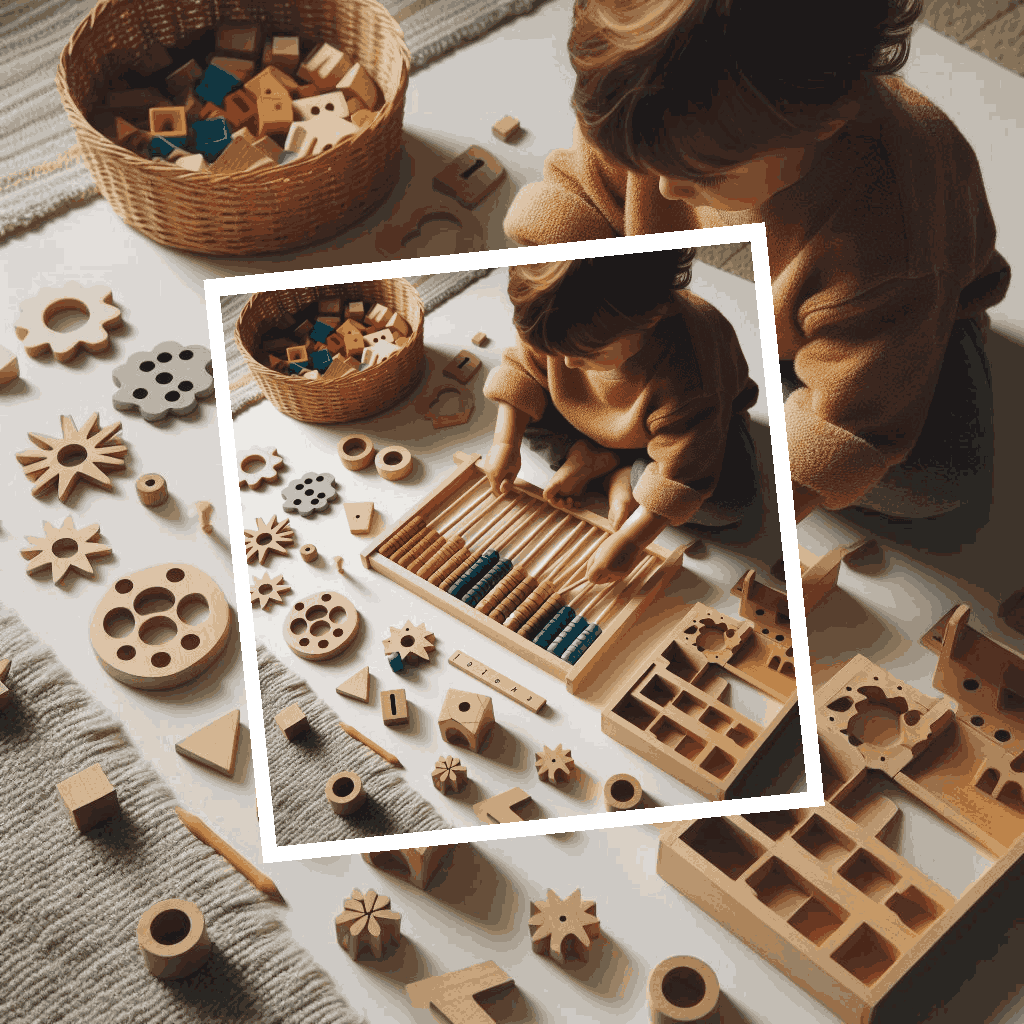
Mathematical Concept Activities
Now that you’ve explored language development activities, it’s time to introduce your toddler to basic mathematical concepts. Montessori-inspired math activities for toddlers focus on hands-on learning and concrete experiences. Here are some engaging activities to help your little one develop early math skills:
A. Number Recognition
To help your toddler recognize numbers, try these activities:
- Number cards: Create or purchase cards with numbers 1-10 and corresponding quantities of objects.
- Sandpaper numbers: Let your child trace numbers cut from sandpaper to connect the symbol with its feel.
- Number hunt: Hide number cards around the room and have your toddler find them in order.
B. Shape Sorting
Shape sorting activities help toddlers understand geometric concepts:
- Shape sorter toys: Use traditional shape sorters or create your own with a shoebox and cut-out shapes.
- Shape matching game: Make cards with different shapes and have your child match them.
- Shape scavenger hunt: Look for objects of specific shapes around your home.
C. Simple Puzzles
Puzzles are excellent for developing problem-solving skills and spatial awareness:
- Knobbed puzzles: Start with simple, single-piece puzzles and gradually increase complexity.
- Shape puzzles: Use puzzles that combine shape recognition with problem-solving.
- Picture puzzles: Introduce simple jigsaw puzzles with familiar images.
D. Counting with Objects
Encourage hands-on counting experiences:
- Counting beads: Use a bead string to practice counting up to 10.
- Counting stones: Collect small stones and practice counting them into groups.
- Counting daily items: Count familiar objects like toys, fruits, or buttons during everyday activities.
| Activity | Benefits | Materials Needed |
|---|---|---|
| Number Recognition | Connects symbols with quantities | Number cards, sandpaper numbers |
| Shape Sorting | Develops geometric understanding | Shape sorters, shape cards |
| Simple Puzzles | Enhances problem-solving skills | Knobbed puzzles, jigsaw puzzles |
| Counting with Objects | Builds number sense | Beads, stones, everyday items |
These Montessori-inspired mathematical activities provide a strong foundation for your toddler’s future math skills. Remember to follow your child’s lead and make the learning process fun and engaging. Next, we’ll explore activities that help develop fine motor skills, an essential aspect of your toddler’s physical development.
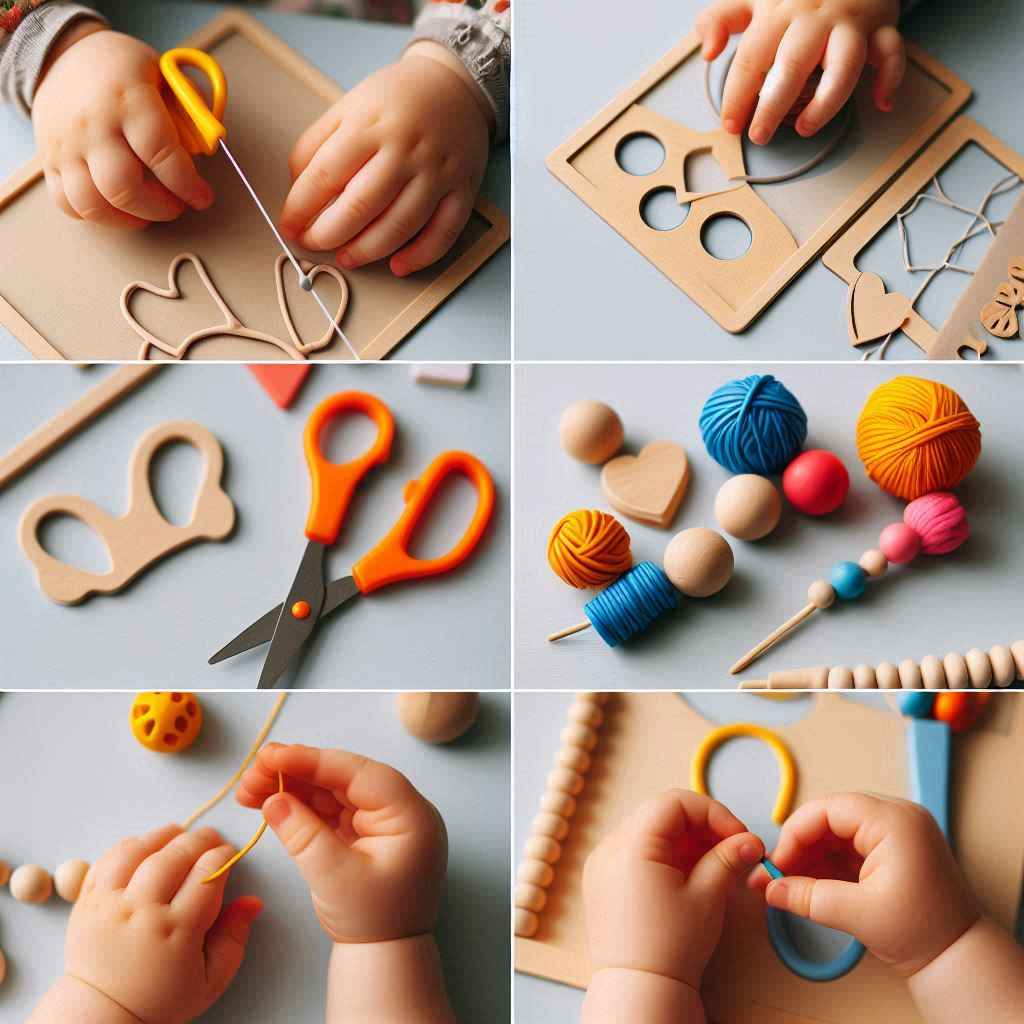
Fine Motor Skill Activities
Now that we’ve explored various Montessori activities, let’s focus on developing your toddler’s fine motor skills. These activities are crucial for enhancing hand-eye coordination and dexterity, which are essential for future writing and self-care tasks.
A. Lacing Cards
Lacing cards are an excellent way to improve your toddler’s hand-eye coordination and concentration. You can create these at home using cardboard and yarn. Cut out simple shapes like circles or stars, punch holes around the edges, and let your child thread the yarn through the holes.
B. Playdough Modeling
Playdough offers a sensory-rich experience while strengthening your toddler’s hand muscles. Encourage your child to:
- Roll the dough into balls
- Flatten it with their palms
- Use cookie cutters to create shapes
- Practice pinching and squeezing the dough
C. Cutting with Child-Safe Scissors
Introduce your toddler to cutting with child-safe scissors. This activity enhances hand strength and coordination. Start with thick paper or playdough strips, then progress to:
- Cutting along straight lines
- Cutting curved lines
- Cutting out simple shapes
Always supervise your child during this activity to ensure safety.
D. Threading Beads
Threading beads is a classic Montessori activity that refines pincer grip and hand-eye coordination. Here’s a progression you can follow:
| Skill Level | Bead Type | String Type |
|---|---|---|
| Beginner | Large wooden beads | Thick shoelace or pipe cleaner |
| Intermediate | Medium-sized beads | Thinner string |
| Advanced | Small beads | Thin string or thread |
Start with larger beads and thicker strings, gradually moving to smaller beads and thinner strings as your child’s skills improve.
These fine motor activities not only develop crucial skills but also provide opportunities for concentration and independence, key aspects of the Montessori approach. As you introduce these activities, remember to demonstrate each task slowly and clearly, allowing your toddler to observe before trying independently.
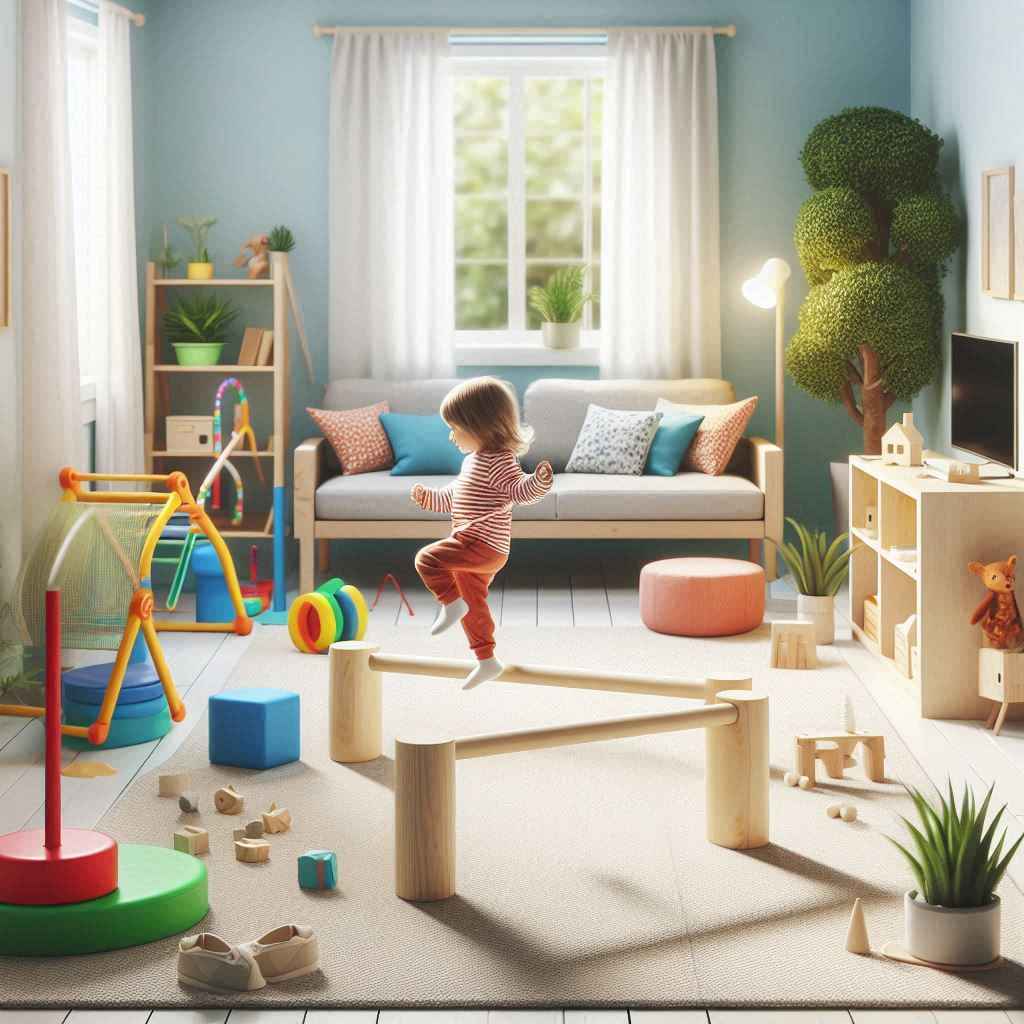
Gross Motor Skill Activities
Now that we’ve explored fine motor skill activities, let’s focus on developing your toddler’s gross motor skills through engaging in Montessori-inspired activities. These activities will help your child improve balance, coordination, and overall physical development.
A. Obstacle Courses
Creating obstacle courses is an excellent way to challenge your toddler’s gross motor skills while making physical activity fun. Here are some ideas for setting up an engaging obstacle course:
- Use cushions for jumping
- Place hula hoops for stepping through
- Set up a tunnel made from cardboard boxes for crawling
- Use painter’s tape to create a zigzag path on the floor
Remember to keep the course age-appropriate and safe for your toddler. Encourage them to complete the course at their own pace, praising their efforts along the way.
B. Balance Beam Walking
Developing balance is crucial for your toddler’s gross motor skills. You can create a simple balance beam at home using:
- A long wooden plank
- A line of tape on the floor
- A rope laid out straight
Start with a wider surface and gradually decrease the width as your child’s skills improve. Always supervise your toddler during this activity to ensure their safety.
C. Dancing and Movement Games
Incorporating music and movement is a fun way to enhance your toddler’s gross motor skills. Try these activities:
- Freeze dance: Play music and encourage your child to dance, then pause the music and have them freeze in place
- Animal movements: Ask your toddler to imitate different animal movements, like hopping like a bunny or crawling like a bear
- Follow the leader: Take turns leading movements for each other to copy
| Activity | Benefits | Materials Needed |
|---|---|---|
| Obstacle Course | Improves coordination and problem-solving | Cushions, hula hoops, boxes |
| Balance Beam | Enhances balance and body awareness | Wooden plank or tape |
| Dancing Games | Develops rhythm and spatial awareness | Music player |
These gross motor skill activities not only support your toddler’s physical development but also promote confidence and body awareness. As we move forward, we’ll explore how to incorporate art and creativity into your toddler’s Montessori experience at home.
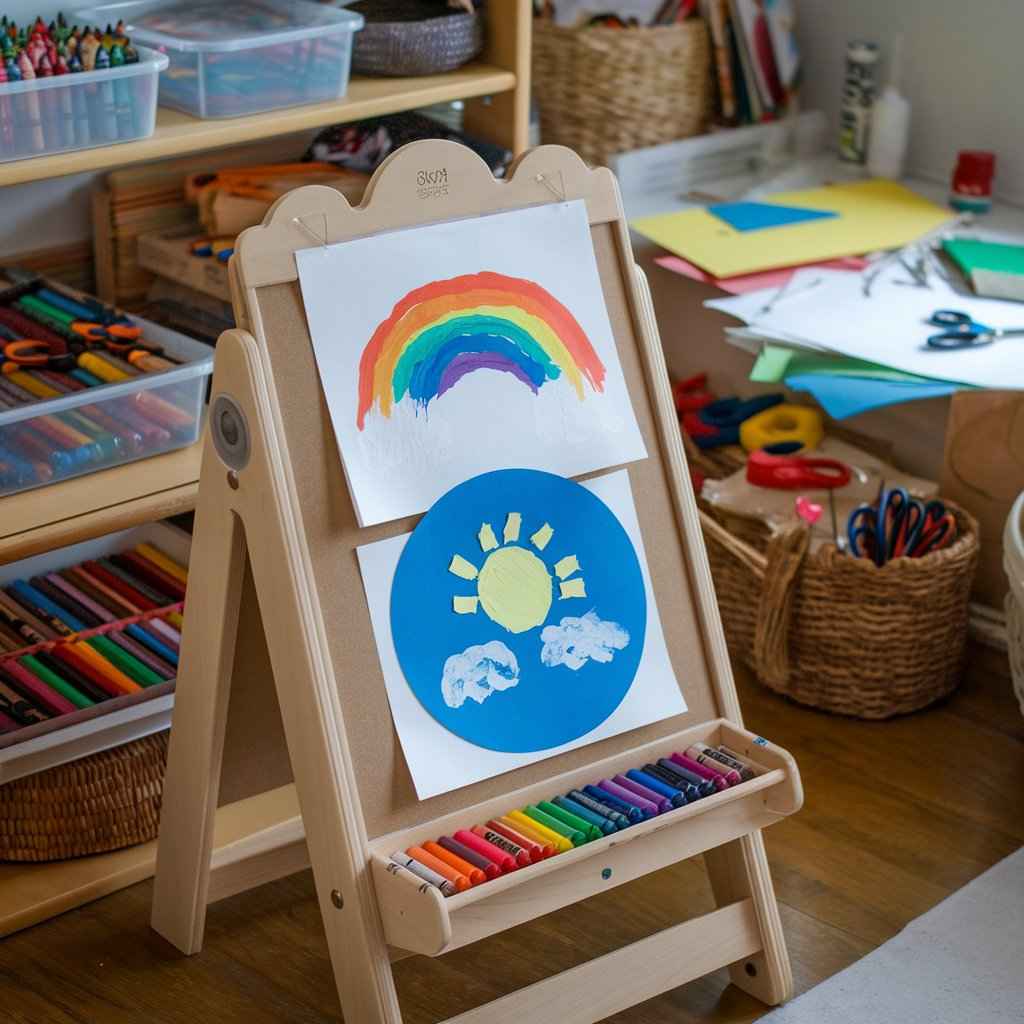
Art and Creativity Activities
Now that we’ve explored various Montessori activities, let’s dive into the world of art and creativity. These activities not only foster your toddler’s imagination but also help develop their fine motor skills and sensory awareness.
A. Finger painting
Finger painting is a fantastic sensory experience for your toddler. It allows them to explore colors, textures, and their own creativity in a hands-on way. Here’s how you can set up a finger-painting activity:
- Prepare washable, non-toxic paints in various colors
- Provide large sheets of paper or a painting easel
- Lay out a protective covering for your work area
- Encourage your toddler to explore the paint with their fingers
Remember to supervise closely and have cleaning supplies ready for the inevitable mess!
B. Collage making
Collage-making is an excellent way to introduce your toddler to different textures and materials while encouraging their creativity. Follow these steps:
- Gather various materials (e.g., colored paper, fabric scraps, leaves, feathers)
- Provide a large piece of sturdy paper or cardboard as a base
- Offer child-safe glue or a glue stick
- Let your toddler choose and arrange the materials as they wish
This activity promotes decision-making skills and artistic expression.
C. Drawing with various tools
Introducing your toddler to different drawing tools can expand their artistic horizons and improve their grip strength. Here’s a comparison of drawing tools you can offer:
| Tool | Benefits | Tips |
|---|---|---|
| Crayons | Thick and easy to hold | Offer chunky, toddler-sized crayons |
| Colored pencils | Precise lines, good for details | Supervise closely due to sharp points |
| Chalk | Fun for outdoor use | Use on sidewalks or a chalkboard |
| Markers | Vibrant colors | Choose washable, non-toxic markers |
Encourage your toddler to experiment with these tools on different surfaces like paper, cardboard, or even a dedicated art wall in your home.
By engaging in these art and creativity activities, your toddler will develop their imagination, fine motor skills, and sensory awareness while having fun. Next, we’ll explore how to set up an ideal Montessori space at home to support these and other activities.
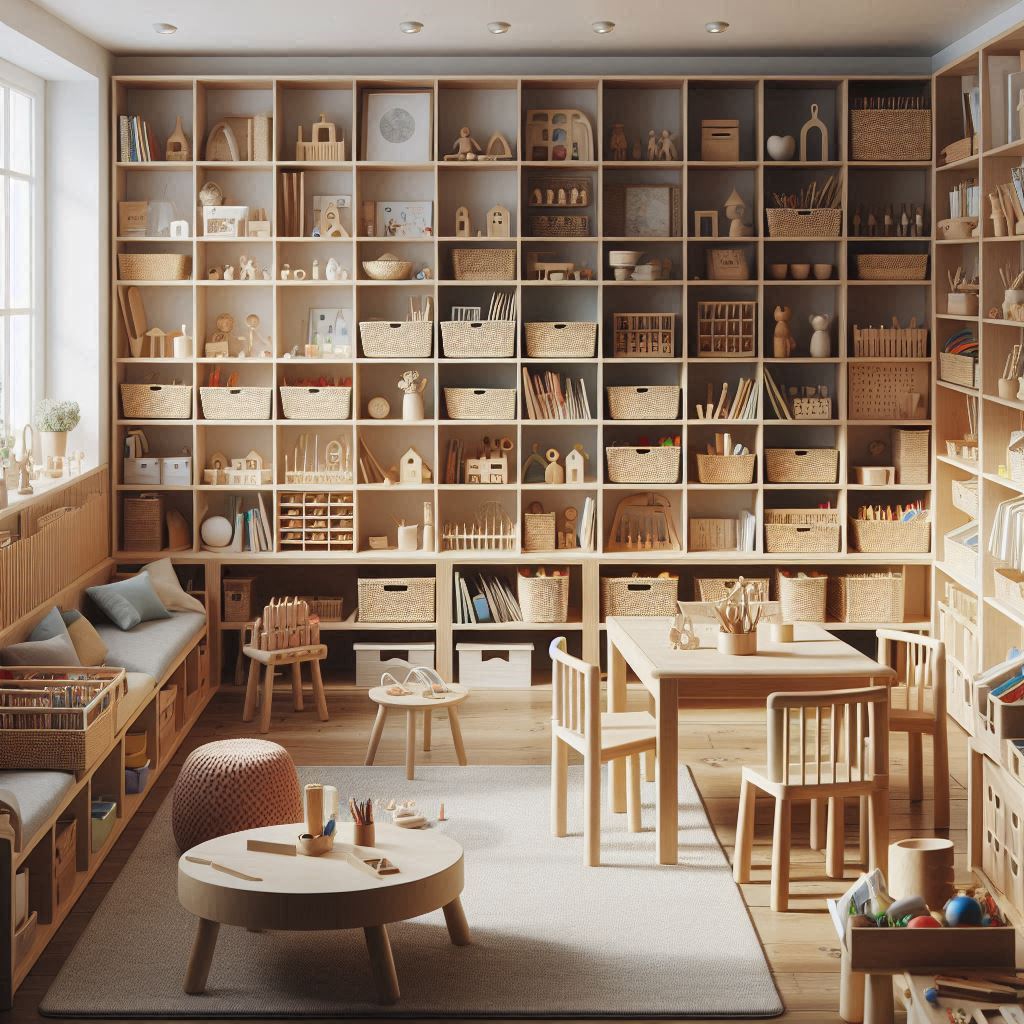
Setting Up Your Montessori Space at Home
Now that you’ve learned about various Montessori activities, it’s time to create an environment where your toddler can thrive. Setting up a Montessori space at home is crucial for fostering independence and learning. Here’s how you can do it:
A. Creating accessible shelves
To empower your toddler’s independence, install low, open shelves that are easily accessible. This allows them to choose and return materials on their own. Consider the following:
- Use sturdy, child-safe shelving units
- Place shelves at your toddler’s eye level
- Ensure shelves are securely anchored to the wall
B. Organizing materials
Proper organization of materials is key to a successful Montessori environment. Follow these tips:
- Group similar items together
- Use baskets or trays to separate activities
- Label containers with pictures for easy identification
| Material Type | Storage Solution | Benefits |
|---|---|---|
| Art supplies | Clear containers | Easy to see and access |
| Puzzles | Individual trays | Keeps pieces together |
| Books | Forward-facing shelves | Encourages reading |
C. Rotating activities
Keep your toddler engaged by regularly rotating activities on the shelves. This practice:
- Maintains interest and curiosity
- Prevents overwhelm by too many choices
- Allows you to introduce new concepts gradually
D. Incorporating child-sized furniture
To promote independence and comfort, include furniture that’s proportionate to your toddler’s size:
- Small table and chairs for activities and meals
- Low bed or floor bed for easy access
- Child-sized cleaning tools (broom, dustpan, mop)
- Step stool for reaching sinks or counters
By creating a well-organized, accessible Montessori space at home, you’re setting the stage for your toddler’s growth and learning. Remember to observe your child’s interests and adjust the environment accordingly to support their development.
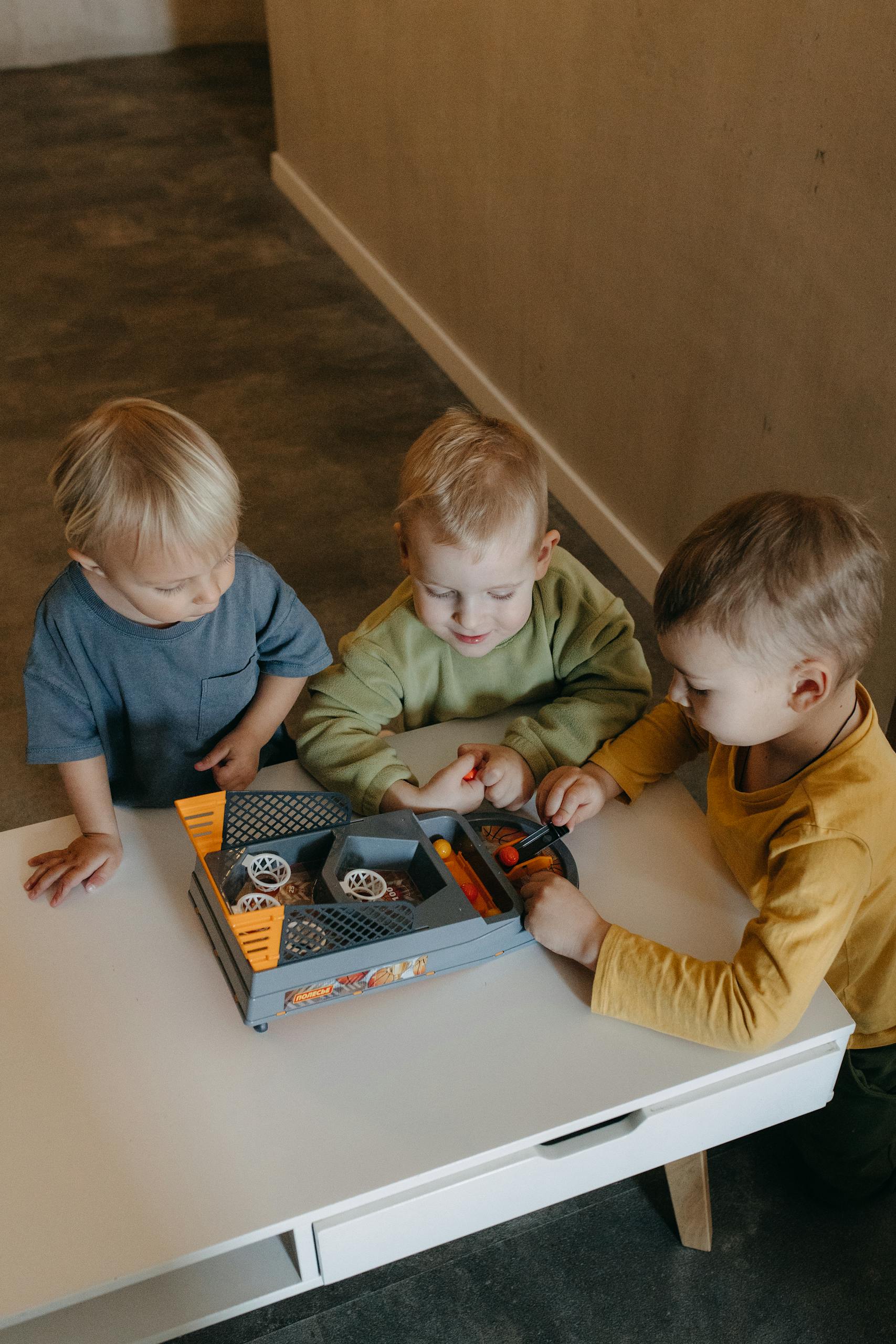
Conclusion
Embracing Montessori activities for toddlers at home offers a wealth of benefits for your child’s development. From practical life skills to sensorial exploration, language development, and mathematical concepts, these activities provide a holistic approach to learning. By incorporating fine and gross motor skill exercises, along with art and creativity projects, you’re nurturing your toddler’s physical abilities and imagination.
Remember, creating a Montessori-inspired environment at home doesn’t have to be complicated or expensive. Start small, focus on your child’s interests, and gradually introduce new activities. By following the principles outlined in this guide, you’re setting the foundation for a lifelong love of learning and independence in your toddler.
Embrace this journey of discovery together, and watch as your little one thrives in their specially curated Montessori space at home.






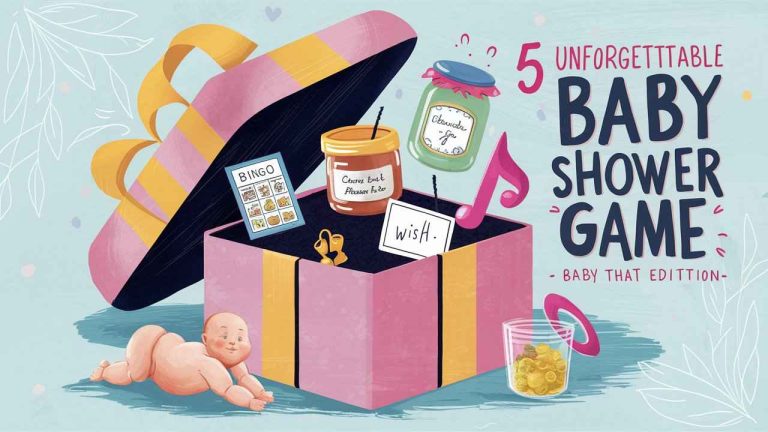
I am continuously browsing online for posts that can assist me. Thx!
I enjoyed reading this article. Thanks for sharing your insights.
Excellent beat ! I would like to apprentice at the same time as you amend your web site, how could i subscribe for a blog site? The account helped me a acceptable deal. I had been a little bit acquainted of this your broadcast offered shiny transparent idea
Hey, you used to write magnificent, but the last several posts have been kinda boringK I miss your tremendous writings. Past several posts are just a little out of track! come on!
I like this weblog so much, saved to my bookmarks.
I don’t know if it’s just me or if everyone else experiencing issues with your
site. It looks like some of the written text on your content are running off the screen.
Can someone else please provide feedback and let me know if this is happening to them too?
This may be a problem with my internet browser
because I’ve had this happen previously. Cheers